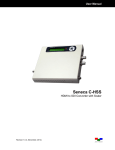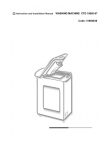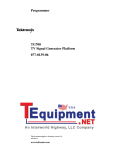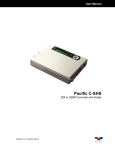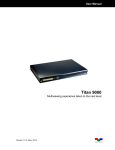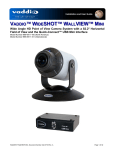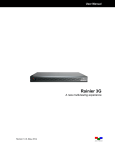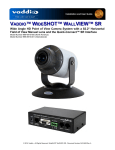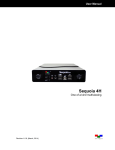Download Avitech Pacific C-SHS User manual
Transcript
User Manual Pacific C-A / C-AG All-in-one Converter box with Scaler Revision 1.0.0, (May, 2014) User Manual ABOUT THIS MANUAL This manual contains information on using the Avitech Pacific C-A / C-AG all-in-one converter. There are 2 chapters in this manual. Getting Started introduces the features and specifications as well as external components of Pacific C-A / C-AG. System Configuration discusses the steps on using the LCD panel to set up Avitech Pacific C-A / C-AG, as well as using the proprietary Avitech PacificConfig utility. The following conventions are used to distinguish elements of text throughout the manual. provides additional hints or information that require special attention. identifies warnings which must be strictly followed. Any name of a menu, command, icon or button on the screen is shown in a bold typeset. For example: On the Start menu select Settings. To assist us in making improvements to this user manual, we welcome any comments and constructive criticism. Email us at: [email protected]. WARNING Do not attempt to disassemble the Pacific all-in-one converter module. Doing so may void the warranty. There are no serviceable parts inside. Please refer all servicing to qualified personnel. TRADEMARKS All brands and product names are trademarks or registered trademarks of their respective companies. COPYRIGHT The information in this manual is subject to change without prior notice. No part of this document may be reproduced or transmitted in any form or by any means, electronic or mechanical for any purpose, without the express written permission of Avitech International Corporation. Avitech International Corporation may have patents, patent applications, trademarks, copyrights or other intellectual property rights covering the subject matter in this document. Except as expressly written by Avitech International Corporation, the furnishing of this document does not provide any license to patents, trademarks, copyrights or other intellectual property of Avitech International Corporation or any of its affiliates. TECHNICAL SUPPORT For any questions regarding the information provided in this guide, call our technical support help line at 425-885-3863, or our toll free help line at 1-877-AVI-TECH, or email us at: [email protected] ii Contents About This Manual .................................................................................................................... ii Warranty..................................................................................................................................... v Limitation of Liability ................................................................................................................ v Extended Warranty Options..................................................................................................... v Services and Repairs Outside the Warranty Period .............................................................. v Regulatory Information ............................................................................................................ v Federal Communications Commission (FCC) Statement ..................................................... v European Union CE Marking and Compliance Notices ........................................................ v Australia and New Zealand C-Tick Marking and Compliance Notice .................................. v 1. Getting Started ............................................................................................................ 1 1.1 Package Contents .............................................................................................................. 1 1.2 Product Features ............................................................................................................... 2 1.3 Specifications .................................................................................................................... 3 1.4 Connections to the Pacific C-A / C-AG ............................................................................ 6 2. System Configuration ................................................................................................. 8 2.1 Using the LCD Panel ......................................................................................................... 8 2.1.1 Welcome Screen ................................................................................................... 8 2.1.2 Navigating the Main Menu .................................................................................... 9 2.2 Using the Avitech PacificConfig Utility ......................................................................... 16 2.2.1 PacificConfig Utility Control Panel .................................................................... 16 2.2.2 Using the PacificConfig Utility ........................................................................... 17 2.2.3 Status Information .............................................................................................. 17 2.3 Using the Avitech ScreenCrop Utility ............................................................................ 18 2.3.1 ScreenCrop Utility Control Panel ...................................................................... 19 2.3.2 Using the ScreenCrop Utility ............................................................................. 21 2.3.3 Status Information .............................................................................................. 21 2.3.4 Cropping Feature ................................................................................................ 22 2.3.5 Cropped Instances Switching ............................................................................ 23 2.3.6 Pan Anywhere...................................................................................................... 24 Appendix A Change the IP Address ............................................................................ 25 Method 1: Change the IP Address of the Pacific C-A / C-AG / C-HSS / C-SHS ................. 25 Method 2: Change the IP Address of the Controlling Computer ....................................... 26 For Windows XP .............................................................................................................. 26 For Windows 7 ................................................................................................................. 26 Output Resolutions ................................................................................................................. 27 Appendix B Resetting to the Factory-Default State.................................................... 28 Method 1 .................................................................................................................................. 28 iii Method 2 .................................................................................................................................. 28 iv Warranty Regulatory Information Avitech International Corporation (herein after referred to as “Avitech”) warrants to the original purchaser of the products manufactured in its facility (the “Product”), that these products will be free from defects in material and workmanship for a period of 1 year or 15 months from the date of shipment of the Product to the purchaser. There is a 3 month grace period between shipping and installation. Marking labels located on the exterior of the device indicate regulations that the model complies with. Please check the marking labels on the device and refer to the corresponding statements in this chapter. Some notices apply to specific models only. Federal Communications Commission (FCC) Statement This equipment has been tested and found to comply with the limits for a Class A digital device, pursuant to Part 15 of the FCC Rules. These limits are designed to provide reasonable protection against harmful interference when the equipment is operated in a commercial environment. This equipment generates, uses, and can radiate radio frequency energy and, if not installed and used in accordance with the instruction manual, may cause harmful interference to radio communications. Operation of this equipment in a residential area is likely to cause harmful interference, in which case the user will be required to correct the interference at his own expense. Properly shielded and grounded cables and connectors must be used in order to meet FCC emission limits. Avitech is not responsible for any radio or television interference caused by using other than recommended cables and connectors or by unauthorized changes or modifications to this equipment. Unauthorized changes or modifications could void the user's authority to operate the equipment. Operation is subject to the following two conditions: (1) this device may not cause harmful interference, and (2) this device must accept any interference received, including interference that may cause undesired operation. If the Product proves to be defective during the 1 year warranty period, the purchaser’s exclusive remedy and Avitech’s sole obligation under this warranty is expressly limited, at Avitech’s sole option, to: (a) repairing the defective Product without charge for parts and labor; or (b) providing a replacement in exchange for the defective Product; or (c) if after a reasonable time is unable to correct the defect or provide a replacement Product in good working order, then the purchaser shall be entitled to recover damages subject to the limitation of liability set forth below. Limitation of Liability Avitech’s liability under this warranty shall not exceed the purchase price paid for the defective product. In no event shall Avitech be liable for any incidental, special, or consequential damages, including without limitation, loss of profits for any breach of this warranty. If Avitech replaces the defective Product with a replacement Product as provided under the terms of this Warranty, in no event will the term of the warranty on the replacement Product exceed the number of months remaining on the warranty covering the defective Product. Equipment manufactured by other suppliers and supplied by Avitech carries the respective manufacturer’s warranty. Avitech assumes no warranty responsibility either expressed or implied for equipment manufactured by others and supplied by Avitech. European Union CE Marking and Compliance Notices Statements of Compliance English This product follows the provisions of the European Directive 1999/5/EC. Dansk (Danish) This Warranty is in lieu of all other warranties expressed or implied, including without limitation, any implied warranty of merchantability or fitness for a particular purpose, all of which are expressly disclaimed. Dette produkt er i overensstemmelse med det europæiske direktiv 1999/5/EC. Nederlands (Dutch) Dit product is in navolging van de bepalingen van Europees Directief 1999/5/EC. This Hardware Warranty shall not apply to any defect, failure, or damage: (a) caused by improper use of the Product or inadequate maintenance and care of the Product; (b) resulting from attempts by other than Avitech representatives to install, repair, or service the Product; (c) caused by installation of the Product in a hostile operating environment or connection of the Product to incompatible equipment; or (d) caused by the modification of the Product or integration with other products when the effect of such modification or integration increases the time or difficulties of servicing the Product. Suomi (Finnish) Tämä tuote noudattaa EU-direktiivin 1999/5/EC määräyksiä. Français (French) Ce produit est conforme aux exigences de la Directive Européenne 1999/5/EC. Deutsch (German) Dieses Produkt entspricht den Bestimmungen der Europäischen Richtlinie 1999/5/EC. Any Product which fails under conditions other than those specifically covered by the Hardware Warranty, will be repaired at the price of parts and labor in effect at the time of repair. Such repairs are warranted for a period of 90 days from date of reshipment to customer. Ελληνικά (Greek) To προϊόν αυτό πληροί τις προβλέψεις της Ευρωπαϊκής Οδηγίας 1999/5/EC. Íslenska (Icelandic) Þessi vara stenst reglugerð Evrópska Efnahags Bandalagsins númer 1999/5/EC. Extended Warranty Options Avitech offers OPTIONAL Extended Warranty plans that provide continuous coverage for the Product after the expiration of the Warranty Period. Contact an Avitech sales representative for details on the options that are available for the Avitech equipment. Italiano (Italian) Questo prodotto è conforme alla Direttiva Europea 1999/5/EC. Norsk (Norwegian) Dette produktet er i henhold til bestemmelsene i det europeiske direktivet 1999/5/EC. Services and Repairs Outside the Warranty Period Avitech makes its best offer to repair a product that is outside the warranty period, provided the product has not reached its end of life (EOL). The minimum charge for such repair excluding shipping and handling is $200 (US dollars). Português (Portuguese) Este produto cumpre com as normas da Diretiva Européia 1999/5/EC. Español (Spanish) Este producto cumple con las normas del Directivo Europeo 1999/5/EC. AVITECH INTERNATIONAL CORPORATION ● 15377 NE 90th Street Redmond, WA 98052 USA ● TOLL FREE 1 877 AVITECH ● PHONE 1 425 885 3863 ● FAX 1 425 885 4726 ● [email protected] ● http://avitechvideo.com Svenska (Swedish) Denna produkt har tillverkats i enlighet med EG-direktiv 1999/5/EC. Australia and New Zealand C-Tick Marking and Compliance Notice Statement of Compliance This product complies with Australia and New Zealand's standards for radio interference. v 1. Getting Started The Pacific C-A / C-AG all-in-one Converter box allows conversion of input signals from HDMI/DVI/ VGA/YPbPr/CVBS (NTSC/PAL) and SDI (3G/HD/SD) to HDMI/DVI/VGA/YPbPr and SDI (3G/HD/SD) output signals with scaling. A compact, stand-alone video converter, it is ideal for many professional video conversion applications, including video production, conferencing, presentations, OB vans, postproduction, and television broadcasting. It provides automatic video input format detection and audio monitoring, supports a wide variety of video resolutions, and is capable of simultaneous output of VGA, DVI, HDMI, YPbPr and SDI signals. This chapter introduces the features and specifications as well as external components of Avitech Pacific C-A / C-AG. 1.1 Package Contents Avitech Pacific C-A / C-AG Utility Disc (software and user manual) 12 V DC 2.5 A Power Adapter Magnetic Foot Stand with Screws (4 pcs) DVI-I to VGA Adapter D 1 DVI-I to YPbPr Adapter (optional) Rack mount kit (optional) D Table 1-1 Package Contents 1.2 Product Features The Pacific C-A / C-AG is capable of converting and scaling signals to a high quality HDMI/DVI/VGA/ YPbPr and SDI signals. It can sense the following input signals: HDMI/DVI/VGA/YPbPr/SDI (3G/HD/SD) /CVBS (NTSC/PAL) automatically, then convert and scale them to the user-defined HDMI/DVI/VGA and SDI/YPbPr signal. The Pacific is capable of simultaneous output of DVI, HDMI, and SDI signals with most resolutions.* It also features a DVI-D LOOP OUT** port for connection to an external display for monitoring of the signal entering the DVI-I IN port. The Pacific C-A / C-AG also supports area of interest cropping through its LCD interface and through a computer connected to the Pacific C-A / C-AG. Additionally, Avitech’s PacificConfig utility*** software can monitor the broadcast output of all networked Pacific devices. For television broadcast application, the Pacific C-A / C-AG supports the setting of safe area graticules, genlock functions (Pacific C-AG) with timing offset controls, and the embedding of analog stereo audio into the SDI/HDMI output with a user defined time delay. The Pacific also has audio monitoring capabilities through a 1/8 inch stereo headphone jack (which can support up to 170ms of delay). The LCD interface on the Pacific C-A / C-AG displays its operational status and input signal information. The LCD interface also allows users to fully configure all the Pacific’s settings. * See the Output Resolution Table in the Appendix of this manual for a complete list of resolutions. ** DVI-D loop out does not support analog source signals; VGA or YPbPr (through VGA or YPbPr to DVI adapter). *** Input port selection, output resolution, and device name and IP address adjustments are also supported by the Avitech PacificConfig software. Note: To comply with the HDCP license agreement, any source with HDCP encryption cannot be converted to SDI. 2 1.3 Specifications Input SDI/CVBS (BNC connector) HDMI (HDMI type A) DVI-I (DVI-I connector) VGA/YPbPr (through adapter) Genlock (BNC connector) Audio (Phono jack) Automatic sensing SDI (3G/HD/SD) CVBS (NTSC/PAL): NTSC/PAL SD-SDI (SMPTE 259M): 525i60, 625i50 HD-SDI (SMPTE 292M): 720p25, 720p29.97, 720p30, 720p50, 720p59.94, 720p60, 1080i50, 1080i59.94, 1080i60 3G-SDI (SMPTE 424M): 1080p23.98, 1080PsF24, 1080p25, 1080p29.97, 1080p30, 1080p50, 1080p59.94, 1080p60 Automatic sensing, the following input signals are supported: 640x480, 60Hz/75Hz 720×400, 70Hz 800x600, 50Hz/60Hz/75Hz 1024x768, 50Hz/60Hz/75Hz 1280x960, 50Hz/60Hz 1280x1024, 50Hz/60Hz/75Hz 1360x765, 50Hz/60Hz 1400x1080, 50Hz/60Hz 1600x1200, 50Hz/60Hz 1680x1050, 50Hz/60Hz 1920x1080, 50Hz/60Hz 1920x1200, 50Hz/60Hz Automatic sensing, the following input signals are supported: 640x480, 60Hz/75Hz 720×400, 70Hz 800x600, 50Hz/60Hz/75Hz 1024x768, 50Hz/60Hz/75Hz 1280x960, 50Hz/60Hz 1280x1024, 50Hz/60Hz/75Hz 1360x765, 50Hz/60Hz 1400x1080, 50Hz/60Hz 1600x1200, 50Hz/60Hz 1680x1050, 50Hz/60Hz 1920x1080, 50Hz/60Hz 1920x1200, 50Hz/60Hz Automatic sensing, through adapter in DVI-I IN port; input signals supported: 800x600, 50Hz/60Hz 1024x768, 50Hz/60Hz 1280x960, 50Hz/60Hz 1280x1024, 50Hz/60Hz 1360x765, 50Hz/60Hz 1400x1080, 50Hz/60Hz 1600x1200, 50Hz/60Hz 1680x1050, 50Hz/60Hz 1920x1080, 50Hz/60Hz 1920x1200, 50Hz/60Hz If the refresh rate is not 60Hz, the image could become out of alignment. In this case, use the “VGA Adjustment” feature to realign. “H START, V START, WIDTH, HEIGHT, and H TOTAL” (through LCD interface). Frame synchronizer (Ref IN port) Note: Port is not available for the Pacific C-A model without genlock feature. Analog audio (AUDIO IN port, stereo) AES/EBU (embedded) 3 Input Ethernet (RJ45 connector) For connecting to a computer and using Avitech PacificConfig utility or performing advanced operations (IP port). Output SDI (BNC connector) YPbPr (DVI-I connector) HDMI (HDMI type A) DVI-I (DVI-I connector) User configurable (support SMPTE 259M, 292M, and 424M at YCbCr 4:2:2/4:4:4 or RGB 4:4:4, 10-/12-bit): SD-SDI: 487i59.94, 576i50 HD-SDI: 720p23.98, 720p24, 720p25, 720p29.97, 720p30, 720p50, 720p59.94, 720p60, 1080PsF23.98, 1080PsF24, 1080i50, 1080i59.94, 1080i60 3G-SDI: 1080p23.98, 1080p24, 1080p25, 1080p29.97, 1080p30, 1080p50, 1080p59.94, 1080p60 User configurable (support SMPTE 425M at XYZ 4:4:4 or RGB 4:4:4, 12-bit): 3G-SDI: 2048p23.98, 2048p24 SDI Embedded Audio (SDI OUT port) Note: For models (Pacific C-A) without genlock feature (no Ref IN port); the following refresh rates are not supported 23.98, 29.97 and 59.94Hz. User configurable: 480i59.94 576i50 720p50, 720p59.94, 720p60 1080PsF23.98, 1080PsF24 1080i50, 1080i59.94, 1080i60 1080p23.98, 1080p24, 1080p25, 1080p29.97, 1080p30, 1080p50, 1080p59.94, 1080p60 Note: For models (Pacific C-A) without genlock feature (no Ref IN port); the following refresh rates are not supported 23.98, 29.97 and 59.94Hz. User configurable: 800x600, 50Hz/60Hz/75Hz 1024x768, 50Hz/60Hz/75Hz 1280x720, 50Hz/60Hz/75Hz 1280x768, 50Hz/60Hz/75Hz 1280x1024, 50Hz/60Hz/75Hz 1360x768, 50Hz/60Hz/75Hz 1400x1050, 50Hz/60Hz/75Hz 1440x900, 50Hz/60Hz/75Hz 1600x1200, 50Hz/60Hz/75Hz 1680x1050,50Hz/60Hz/75Hz 1920x1080, 50Hz/60Hz User configurable: 640x480, 60Hz 800x600, 50Hz/60Hz/75Hz 1024x768, 50Hz/60Hz/75Hz 1280x720, 50Hz/60Hz/75Hz 1280x768, 50Hz/60Hz/75Hz 1280x1024, 50Hz/60Hz/75Hz 1360x768, 50Hz/60Hz/75Hz 1400x1050, 50Hz/60Hz/75Hz 1440x900, 50Hz/60Hz/75Hz 1600x1200, 50Hz/60Hz/75Hz 1680x1050,50Hz/60Hz/75Hz 1920x1080, 50Hz/60Hz 1920x1200, 50Hz/60Hz 4 Output VGA (DVI-I connector) DVI-D Loopout (DVI-D connector) Audio (Headphone jack) User configurable: 640x480, 60Hz 800x600, 50Hz/60Hz/75Hz 1024x768, 50Hz/60Hz/75Hz 1280x720, 50Hz/60Hz/75Hz 1280x768, 50Hz/60Hz/75Hz 1280x1024, 50Hz/60Hz/75Hz 1360x768, 50Hz/60Hz/75Hz 1400x1050, 50Hz/60Hz/75Hz 1440x900, 50Hz/60Hz/75Hz 1600x1200, 50Hz/60Hz/75Hz 1680x1050,50Hz/60Hz/75Hz 1920x1080, 50Hz/60Hz 1920x1200, 50Hz/60Hz Looping output of the DVI-I input (non-configurable and not available for VGA or YPbPr signal through DVI adapter): 640x480, 60Hz/75Hz 720×400, 70Hz 800x600, 50Hz/60Hz/75Hz 1024x768, 50Hz/60Hz/75Hz 1280x960, 50Hz/60Hz 1280x1024, 50Hz/60Hz/75Hz 1360x765, 50Hz/60Hz 1400x1080, 50Hz/60Hz 1600x1200, 50Hz/60Hz 1680x1050, 50Hz/60Hz 1920x1080, 50Hz/60Hz 1920x1200, 50Hz/60Hz Analog Audio (audio out port) Stereo Others Power Dimensions/ Weight Environment/ Safety Power consumption is 15 W maximum Input (AC): 100 to 250 V Output (DC): 12 V adapter Dimensions: 174×172×43 mm (6.85×6.77×1.69 inch) Weight: 740 g (1.63 lb) Temperature: Operating: 0 C (32 F) to 40 C (104 F) Storage: –10 C (14 F) to 50 C (122 F) Humidity: 0% to 80% relative, non-condensing Safety: FCC/CE/C-Tick/Class A Table 1-2 Specifications 5 1.4 Connections to the Pacific C-A / C-AG Figure 1-1 Pacific C-A / C-AG Components Front Panel LCD Panel Control Buttons System Fan Displays the configuration and control parameters Go to previous selection Go to next selection Enters next menu level or select item Contains the system fan* Rear Panel Ethernet (IP) Allows a computer to control the Pacific C-A / C-AG through a network connection through an Ethernet cable. (use with Avitech’s PacificConfig utility software) Audio In/Out DVI-D LOOP OUT Ref IN SDI OUT DVI-I IN HDMI OUT HDMI IN DVI-I OUT SDI/CVBS IN Power (DC 12V) Connects to the green connector for headphone function (stereo) IN Connects to the pink connector for analog audio input DVI connector for DVI video out loop (output signal coming from DVI-I IN port only)** Note: Often used for preview when the connected desktop computer is only capable of supporting a single display output Multi-format sync reference input (YPbPr/NTSC/PAL) for genlock function (frame synchronizer) Note: Port is not available for model (Pacific C-A) without genlock feature. BNC connector supports SDI (3G/HD/SD) signal output DVI connector for DVI/VGA/YPbPr input sources (a DVI to VGA adapter or DVI to YPbPr adapter may be required) Connects to the monitor’s HDMI signal cable HDMI connector for HDMI input source*** Connects to the monitor’s DVI / YPbPr and VGA (through adapter) signal cable BNC connector for SDI (3G/HD/SD) / CVBS (NTSC/PAL) video sources Connects to the 12 V DC power adapter Table 1-3 Pacific C-A / C-AG Component Description 6 * Do not cover or block the ventilation openings. ** DVI-D loop out does not support analog source signals; VGA or YPbPr (through VGA or YPbPr to DVI adapter). *** To comply with the HDCP license agreement, any source with HDCP encryption cannot be converted to SDI. 7 2. System Configuration This chapter discusses the process of using the LCD panel to set up the Pacific C-A / C-AG, as well as instructions on how to use the Avitech PacificConfig utility software. 2.1 Using the LCD Panel The LCD panel allows for control of the Pacific C-A / C-AG including features such as input/output signal adjustments, video cropping, keying/overlay, aspect ratio adjustments and operational status reports. The LCD panel consists of 3 buttons: Go to previous selection (up arrow button) Go to next selection (down arrow button) Enter the next level of a menu, or select the currently highlighted item. Figure 2-1 LCD Panel: Busy State 1. 2. When the busy state “PLEASE WAIT . . . .” message is displayed on the LCD panel (see sample screen above), DO NOT disconnect or connect any signal cables as a fault may occur. Also, DO NOT change any of the incoming signal’s display resolutions while the Pacific C-A / C-AG is in the busy state. 2.1.1 Welcome Screen Upon starting up the LCD panel, the welcome screen is shown for about 15 seconds. Figure 2-2 LCD Panel: Welcome Screen Then the following default screen is displayed. Figure 2-3 LCD Panel: Default Initial Screen This screen displays the unit’s default settings. 1. First line (video): Automatically selects the input signal in the following order (firstly CVBS, SDI, YPbPr, VGA, DVI, and lastly HDMI) when more than one signal type is detected. Then, outputs it at 1080p @ 60Hz. Note: Due to the screen display size constraint, (A:AUTO, H:HDMI, V:VGA, Y:YPbPr, S:SDI, D:DVI). 2. Second line (audio): The default audio signal source is set at “Follow Video” (e.g., HDMI). The audio feature allows the selection of an audio signal source (Follow Video, HDMI, SDI, LINE IN). By default the audio time delay is set to: 0 (no audio delay). The Pacific C-A / C-AG supports up to 170ms of time delay. Settings made through the LCD panel will be saved automatically upon powering off the Pacific. 8 2.1.2 Navigating the Main Menu 1. Press the button from the default initial screen to enter the main menu. 2. Use the buttons on the front panel to navigate: ( / / ) 3. There are a number of tables below, each detailing an item on the main menu (Input Port, Output Port… etc.) Within each table is listed the choices that can be made within each item. Input Port Autoscan Exit On: enables the signal automatic detection feature. Off: selects the signal manually. Source: HDMI DVI VGA YPbPr SDI Exits the input signal setup menu. Table 2-1 Input Port If selecting the signal manually, make sure to select the correct signal type based on the actual connected input signal to the Pacific C-A / C-AG to avoid image display problems (e.g., noise, flicker, etc.). Output Port SDI Enable YPbPr Enable Standard Output Timing On: enables SDI out feature (default setting). Off: disables SDI out feature. On: enables YPbPr out feature. Off: disables YPbPr out feature (default setting). Note: Make sure to select “Off” when outputting VGA signal on “DVI-I OUT” port (through DVI-I to VGA adapter) to avoid a color display problem. SMPTE: select this for SDI/YPbPr output. VESA: select this for HDMI/DVI/VGA output. For SMPTE standard, select the following output signal. 2048p @ 23.98, 24 (Hz) 1080p @ 23.98, 24, 25, 29.97, 30, 50, 59.94, 60 (Hz) 1080i @ 50, 59.94, 60 (Hz) 1080PsF @ 23.98, 24 (Hz) 720p @ 23.98, 24, 25, 29.97, 30, 50, 59.94, 60 (Hz) SD_625 (576i @ 50 Hz) SD_525 (487i @ 59.94 Hz) For VESA standard, select the following output signal. 1920x1200 @ 50, 60 (Hz) 1920x1080 @ 50, 60 (Hz) 1680x1050 @ 50, 60, 75 (Hz) 1600x1200 @ 50, 60, 75 (Hz) 1440x900 @ 50, 60, 75 (Hz) 1400x1050 @ 50, 60, 75 (Hz) 1360x768 @ 50, 60, 75 (Hz) 1280x1024 @ 50, 60, 75 (Hz) 1280x768 @ 50, 60, 75 (Hz) 1280x720 @ 50, 60, 75 (Hz) 1024x768 @ 50, 60, 75 (Hz) 800x600 @ 50, 60, 75 (Hz) 640x480 @ 60 (Hz) Note: For models (Pacific C-A) without the genlock feature (no Ref IN port); 23.98, 29.97 and 59.94Hz refresh rates are not supported. 9 Output Port Exit Exits the output signal setup menu. Table 2-2 Output Port Map Structure Selects the desired “sampling structure/pixel depth” based on output signal’s “image format” and “frame/field rate.” YCbCr42210-bit425M Level A/B 425M Level B is only available for 1080p@50, [email protected], 1080p@60, [email protected], 2048p@24 (Hz) YCbCr44410-bit425M Level A RGB44412-bit425M Level A/B XYZ44412-bit425M Level A/B Exits the map structure setup menu. Status Exit Table 2-3 Map Structure 1. 2. 3. Map structure is not available when “OUTPUT PORT””STANDARD” is set at “VESA.” Map structure is locked at YCbCr422 when output resolution is at SD_525, SD_625, 1080p@50, [email protected], 1080p@60 (Hz). Map structure can only be RGB444 or XYZ444 when output resolution is at [email protected], 2048p@24 (Hz). OSD (on screen display) Color Bar Exit On: enables the color bar and current pattern select feature. The color bar can only be turned on when there is no input signal. (default setting is On) COLOR BAR 2×2 CROSSHATCH Off: disables the display of the color bar. Exits the OSD setup menu. Table 2-4 OSD The color bar feature is a pattern generator for showing a signal when there is no input signal. It can be utilized as test pattern (input signal) for self testing or verification for other devices. Image Adjustment The input port currently selected is displayed as follows, (Input Port: VGA, Input Port: CVBS, etc.) If the selected input is digital such as SDI, DVI, or HDMI then the “VGA Adjustment” and “CVBS/YPbPr Adjustment” portions of the image adjustment menu are not available. With digital signals use the (“Image Adjustment” / “Parameter”) portion of the menu. When the selected input signal is VGA, CVBS, or YPbPr, the “VGA Adjustment” and “CVBS/YPbPr Adjustment” portions of the “Image Adjustment” menu are available. Status Auto-detect (firstly CVBS, SDI, YPbPr, VGA, DVI, and lastly HDMI) VGA Adjustment: this feature is designed to adjust an analog VGA signal that may be misaligned or off-color due to a long cabling situation. Note: Only available when the signal is VGA. DEFAULT HSTART (horizontal starting position) WIDTH (horizontal “active area”) VSTART (vertical starting position) 10 Image Adjustment HEIGHT (vertical “active area”) HTOTAL (horizontal total) ****(refer to the figure below) Make sure the value of HSTART added to the value of WIDTH does not exceed HTOTAL. Note: V TOTAL: (vertical total) ****(refer to the figure below) Make sure the value of VSTART added to the value of HEIGHT does not exceed V TOTAL. Exit REDGAIN GREENGAIN BLUEGAIN AUTO ADJUST (performs automatic alignment of VGA image inside the window) AUTO GAIN (performs automatic gain adjustment by correcting the color values) CVBS/YPbPr Adjustment: this feature is designed to adjust a CVBS or YPbPr misaligned or color-off signal due to a long cabling situation. Note: Only available when the signal is CVBS or YPbPr. DEFAULT HSTART (horizontal starting position) WIDTH (horizontal “active area”) VSTART (vertical starting position) HEIGHT (vertical “active area”) HTOTAL (horizontal total) ****(refer to the figure above) Make sure the value of HSTART added to the value of WIDTH does not exceed HTOTAL. Note: V TOTAL: (vertical total) ****(refer to the figure above) Make sure the value of VSTART added to the value of HEIGHT does not exceed V TOTAL. Parameter: LAMBDA (only available when output signal is set at [email protected], 2048p@24 and Map Structure is set at XYZ444) * BRIGHTNESS CONTRAST SHARPNESS SATURATION (only available when signal is non-RGB; or HDMI YCbCr422 / interlaced. It can only be set for YUV color space.) HUE (only available when signal is non-RGB; or HDMI YCbCr422 / interlaced. It can only be set for YUV color space.) DEFAULT Exits the image adjustment setup menu. Table 2-5 Image Adjustment 11 1. Image misalignment is most likely to occur with VGA signals in the 50Hz timing frequency range and the less commonly used resolutions in the 60Hz timing frequency range. a) When switching between VGA resolution signals that have timing frequencies (horizontal and vertical frequency, vertical total) that are very similar, image misalignment may occur. b) e.g., 1280×1024 60Hz change to 1400×1050 60Hz (adjust HSTART/VSTART/WIDTH/HEIGHT) back to 1280×1024 60Hz (since the timing frequency is very near that of 1400×1050 60Hz, adjust HSTART/VSTART/WIDTH/HEIGHT for 1280×1024 60Hz again to prevent image misalignment). 2. Depending on the signal type, SATURATION and HUE can only be set for YUV color space. a) YUV is a color space typically used as part of a color image pipeline. Taking human perception into account, YUV encodes a color image or video, allowing reduced bandwidth for chrominance components. This typically masks transmission errors or compression artifacts more efficiently than using a "direct" RGB-representation. b) When the HDMI signal is transmitted under YCbCr422 color space (set from HDMI device itself), Pacific C-A / C-AG will enable the SATURATION and HUE function in IMAGE PARAMETER menu. If the HDMI signal is under YCbCr444 color space, the SATURATION and HUE functions will be disabled. * In compliance with ST 431-1:2006 (SMPTE standard that specifies the absolute luminance level, white point chromaticity, and luminance uniformity of the reflected screen light for the presentation of motion pictures by projectors with digital light engines in review rooms and commercial cinemas. The purpose of this specification is to achieve the tone scale and contrast in the projected image that will correspond to that intended during the mastering process), this item allows the adjustment of the “L” value in the decoding where Y’ is the DCDM (Digital Cinema Distribution equation for luminance: Master) code value for luminance, Y is luminance, and L is 48.0. The following “white luminance value” table includes the value for (Parameter), (Reference), (Review Room Tolerances), and (Theater Tolerances). 2 MAKE SURE that 48.0 cd/m is the basis (Reference) for the adjustment, then use the “Lambda” item in the LCD panel (–10 to 10) to adjust the Theater Tolerance. Reference: The desired parameter level or value. This is the value relative to defined tolerances. Review Room: A theater in which critical image decisions are made. Theater: A facility in which a paying customer views the images. The projector should be set-up and run according to the manufacturer’s specifications. For these measurements, the projector must be turned on and allowed to stabilize for at least 20 minutes before any measurements are taken. The room lights in the theater should be turned off (except for lighting provided for safety reasons), in order to equal the normal theater operating conditions. The projector must receive images defined by the X’Y’Z’ code values (refer to the next table; the last column when added up corresponds to the “L” value of approximately 48.0). 12 Crop Image Status Exit On: adjusts the crop area and location. LEFT: sets the horizontal starting point. TOP: sets the vertical starting point. RIGHT: sets the horizontal ending point. BOTTOM: sets the vertical ending point. DEFAULT Off: disables the crop image feature. Exits the crop image setup menu. Table 2-6 Crop Image 1. 2. The CROP IMAGE feature will be turned Off when KEYING feature is enabled. Make sure the difference in value between LEFT and RIGHT is not less than 20% (e.g., LEFT = 80.0% RIGHT = 100.0%). Likewise, the difference in value between TOP and BOTTOM must not be less than 20% (e.g., TOP = 80.0% BOTTOM = 100.0%). Put simply, the smallest crop size that is valid is 20% the total height by 20% the total width. Aspect Ratio Status Exit On: sets the display’s aspect ratio. 4:3 16:9 AUTO CUSTOM 1 to 20 for width ratio : 1 to 20 for height ratio. Off: disables the aspect ratio detect feature. Exits the aspect ratio setup menu. Table 2-7 Aspect Ratio 1. 2. 3. The ASPECT RATIO feature will be turned Off when KEYING feature is enabled. When the width is greater than the height, the width cannot be more than 6 times the value of the height. (6:1 ratio) Likewise, when the height is greater than the width, the height cannot be more than 6 times the value of the width. (1:6 ratio) Keying (Overlay) Status Exit On: This superimposes the inputted computer image on top of an existing video signal. This feature works best with green screens and virtual sets. CROP IMAGE: set the crop area parameters. OUTPUT WINDOW: set output video range. BACKGROUND COLOR: set background color range (RGB) DEFAULT Off: disables the keying feature. Exits the keying setup menu. Table 2-8 Keying The KEYING feature will be turned Off when the CROP IMAGE or ASPECT RATIO features are enabled. Color Correct(ion) Status Exit On: enables the color correction feature. Off: disables the color correction feature. Exits the color correction setup menu. Table 2-9 Color Correction 13 1. 2. This function is applicable for 1080p input signal only. When the Pacific C-A / C-AG (SDI OUT) is connected to the Pacific C-SHS (SDI IN), make sure that the Pacific C-A / C-AG’s COLOR CORRECT function is enabled (set On) and the Pacific C-SHS’s COLOR CORRECT function is disabled (set Off) to allow the embedded color corrected signal to pass through. Genlock Status Exit On: This feature in the Pacific C-AG synchronizes the video sources (Signals from DVI-I IN, SDI/CVBS IN, and HDMI IN ports will be synchronized with the Ref IN port signal). GENLOCK OUTPUT: refer to table 2-11 for more details on supported output standard. TIMING OFFSET: sets the delay lines. for SD 525 signal up to 524 delay lines for SD 625 signal up to 624 delay lines for 720p signal up to 749 delay lines for 1080p or 1080i or 2048p signal up to 1124 delay lines Off: disables the genlock feature. Exits the genlock setup menu. Table 2-10 Genlock 1. 2. 3. For models (Pacific C-A) without the genlock feature, this item is not available for configuration. Genlock feature is not available when “OUTPUT PORT””STANDARD” is set to “VESA.” The genlock feature requires a sync reference signal entering the Ref IN port. Changing or disconnecting the sync reference will cause the Pacific to automatically turn off genlock. Table 2-11 Genlock Output 14 Headphone Enables audio output through headphones. SOURCE: selects from the available 4 source channels. CH1, CH2, CH3, CH4 MIX MODE: selects the left/right/both channels. LCH, RCH, R/L VOLUME: adjusts the volume. 1 up to 127 (level – Each press of the button moves one cursor position to the right. A long press of button accepts the value entered). Exits the headphone setup menu. Status Exit Table 2-12 Headphone Audio On: enables the audio output. SOURCE: selects the audio source. HDMI LINE IN SDI DELAY: sets the delay times. 0 to 170ms, sample rate at 48kHz (Each press of the button moves one cursor position to the right. A long press of button accepts the value entered). FOLLOW VIDEO: enables (On) auto switching of audio source to selected video source. Off: disables the audio output. Exits the audio setup menu. Status Exit Table 2-13 Audio Setup Backlight Contrast Idle Time Reset BIOS Version IP Address Exit On: enables the LCD panel's backlight. Off: disables the LCD panel's backlight. Sets the LCD panel's contrast from 0 to 16. On: scrolling text (conversion format and related frame rate) will appear when the LCD panel of Pacific C-A / C-AG is idle. 15 mins 30 mins 45 mins 60 mins Off: disables the scrolling text feature. On: resets to default setting, system reboot is required. Off: keeps present setting. Shows the current firmware version for reference. Allows user to modify the IP ADDRESS, SUBNET MASK, and GATEWAY based on their Ethernet environment. Note: Each press of the button moves one cursor position to the right. A long press of button accepts the value entered. Exits the setup menu. Table 2-14 Setup 15 2.2 Using the Avitech PacificConfig Utility This utility can only be used with the Windows operating system. The Pacific C-A / C-AG comes with a windows based user interface called PacificConfig. Avitech’s PacificConfig utility is easy to use and hosts several powerful tools including: Input port selection Easy adjustment of the output resolution and timing The ability to control up to 153 Pacific converters through a network connection 2.2.1 PacificConfig Utility Control Panel Figure 2-4 PacificConfig Utility Control Panel Status Information Devices on Network IP List Refresh Button Change IP Displays all detected Avitech Pacific Converters in the same network mask. The status button will become active (not grayed-out) when Pacific C-A / C-AG / C-HSS / C-SHS is selected from the Devices on Network window. Click the IP list refresh button to update the connected Avitech devices’ IP addresses in the same network mask. Changes the IP address of the selected Pacific C-A / C-AG / C-HSS / C-SHS. Status Button View the operational status of the selected Pacific C-A / C-AG / C-HSS / C-SHS. C-A / C-AG / C-HSS / C-SHS Displays what type of Pacific converter is currently connected. Input Port Specifies the input signal source (HDMI/DVI/VGA/YPbPr/SDI) or Autoscan (automatically selects the input signal in the following order (firstly CVBS, SDI, YPbPr, VGA, DVI, and lastly HDMI) when more than one signal type is detected). Note: Make sure to select the correct signal type based on the actual input signal to the Pacific C-A / C-AG to avoid image display problems (e.g., noise, flicker, etc.). Upon quitting PacificConfig utility, the last selected input signal source which was stored through “Saved to Flash” button will be automatically shown upon next start-up of the utility. If input signal source of the last saved selection is not available upon restarting PacificConfig utility, then the input port will need to be reset. (refer to section 2.1.2, “SETUP” item to “RESET”). 16 Status Information Output Resolution Save to Flash Disconnect For configuring the specific output resolution and related frame rate. Note: The following frame rates are not supported: 23.98, 29.97 and 59.94Hz for models (like the Pacific C-A) without genlock feature (no Ref IN port). Saves the current PacificConfig session’s parameters to the flash memory of the Pacific C-A / C-AG. The settings will be automatically loaded on next PacificConfig session. Terminates connection of selected Pacific C-A / C-AG / C-HSS / C-SHS. Table 2-15 PacificConfig Utility Control Panel Description 2.2.2 Using the PacificConfig Utility Before using the PacificConfig utility to control Pacific C-A / C-AG, it needs to be set in the same network mask as the connected computer. Please refer to the “Appendix” for further details on setting up the network mask. To use the PacificConfig utility, perform the following steps: Step 1. Copy the three PacificConfig utility system files to the computer. Step 2. Double-click PacificConfig.exe. In case an alert screen appears, click Unblock to continue. A Windows Security Alert screen may appear upon using PacificConfig utility for the first time on a computer. Click Unblock, and the Windows Alert will not appear on subsequent uses of PacificConfig. 2.2.3 Status Information PacificConfig utility allows for easy monitoring of all networked Pacific devices. With 2 clicks of the mouse, view the operational status of any of the Pacific converters that are on the network. Step 1. Click to select the desired IP address from the Devices on Network window. This action will connect to that particular Pacific device. The “Status” button will be enabled and the radio button for that Pacific C-A or Pacific C-AG or Pacific C-HSS or Pacific C-SHS would be faintly highlighted. Step 2. Click the “Status” button and a popup window will display detailed information about that device’s operational status and broadcast output. Displays the Pacific converter’s status information such as input signal type, output resolution and related frame rate, audio source, color correction on/off, sampling, pixel depth, genlock on/off (optional); and input timing such as horizontal/vertical frequency, vertical total lines, horizontal total/start pixel, and vertical start line. Figure 2-5 Detailed Information of Connected Pacific C-A / C-AG 17 2.3 Using the Avitech ScreenCrop Utility 1. 2. This utility can only be used with the Windows operating system. This utility’s cropping feature cannot be used when KEYING is enabled (Status: ON) in the LCD panel. For ScreenCrop to display correctly: 1. When using a computer that does not support dual displays, make sure to use a DVI cable (or a HDMI ® cable with a HDMI-to-DVI adapter) for the DVI-I IN port of Pacific to receive the signal. Next, connect a second monitor to the DVI-D LOOP OUT port of the Pacific. 2. When using a computer with a built-in monitor such as a laptop or an all in one computer or when using a computer that supports dual display outputs, then can connect to the Pacific C-A simply through the HDMI IN port. The Pacific C-A comes with a windows-based user interface called ScreenCrop. Avitech’s ScreenCrop utility is easy to use and hosts several powerful tools that include: Live Pan Preview Area of Interest cropping (supports 2 instances) Cropped-area scaling Easy adjustment of the output resolution and timing The ability to control up to 153 Pacific converters through an Ethernet connection With ScreenCrop utility: Easily air Microsoft PowerPoint presentations and other computer-based content. Selects and scales YouTube windows to fit any broadcast output resolution. Crops out extraneous interface toolbars and broadcasts clean Google Earth maps. Outputs any video stream playing on any media player, such as QuickTime, VLC, or Windows Media Player. 18 2.3.1 ScreenCrop Utility Control Panel Figure 2-6 ScreenCrop Utility Control Panel Status Information (1) Devices on Network IP List Refresh Button Change IP C-A / C-AG / C-HSS / C-SHS Input Port Output Resolution Status Button Displays all detected Avitech’s Pacific converters in the same network mask. The status button becomes active (not grayed-out) when Pacific C-A/C-AG/C-HSS/C-SHS is selected from the IP LIST window. Click the IP list refresh button to update the connected Avitech devices’ IP address in the same network mask. Changes the IP address of selected Pacific C-A/C-AG/C-HSS/C-SHS. Displays what type of Pacific converter is currently connected. Specify the source port of the input signal or select “Autoscan.” Configures the specific output resolution and related frame rate. Shows the operational status of the selected Pacific C-A/C-AG/ C-HSS/C-SHS. This button is only available (not grayed-out) when the Pacific C-A/C-AG/C-HSS/C-SHS is selected in the “IP LIST” window (refer to section 2.3.3 for details). Cropping Feature (2) Left/Top/Width/ Height Set Instance Displays and adjusts the cropped instance’s size and related location. After entering/adjusting the Left/Top/Width/Height parameters, click this button to change the location of the four green cropping corners. Chooses between 2 different area of interest instances (Instance One or Two) and then set the cropping parameters. 19 Cropping Feature (2) Switch Instance Ratio Crosshair Crop Repeated Pan Send Crop Disable Crop If both Instance One and Instance Two cropping parameters have been set, then clicking the Switch Instance button will toggle between the 2 instances and automatically output the cropping parameters. Sets a fixed (1:1, 3:2, 4:3, 5:4, 16:9) aspect ratio or a non-fixed (Any) aspect ratio for any area of interest. Automatically selects a window/object to be cropped by positioning the “crosshair” on the desired window/object. For example, auto-selects a YouTube window or a Google Map. Crops an area by dragging the cursor. Upon releasing the left mouse button, 4 green cropping corners will display the area just selected (area of interest). Enables the pan feature for cropped instance (pan anywhere). Sends the cropped instance to the selected Pacific C-A. Disables the cropping. Cropping feature is only available on the Pacific C-A / C-AG / C-HSS. Others (3) Save to Flash Disconnect Saves the current ScreenCrop session’s parameter to the flash memory of the Pacific C-A. The settings can be automatically loaded on the next ScreenCrop session. Terminates the connection of selected Pacific device. Table 2-16 ScreenCrop Utility Control Panel Description 20 2.3.2 Using the ScreenCrop Utility Before using the ScreenCrop utility to control the Pacific C-A, set it in the same network mask with the connected computer. Refer to the “Appendix A” for further details on setting up the network mask. To use the ScreenCrop utility, perform the following steps: Step 1. Copy the 3 ScreenCrop utility system files to the computer. Step 2. Double-click ScreenCrop.exe. A Windows Security Alert screen may appear upon using ScreenCrop utility for the first time on a computer. Click Unblock, and the Windows Alert will not appear on subsequent uses of ScreenCrop. 2.3.3 Status Information ScreenCrop utility allows for easy monitoring of all networked Pacific devices. With 2 clicks of the mouse, fully operate any Pacific converters that are on the network. Step 1. Click to select the desired IP address from the “Device on Network” window. This will connect to that particular Pacific device. The “Status” button will be enabled and the radio button for the selected Pacific device will be faintly highlighted. Step 2. Clicking the “Status” button will display a pop-up window that shows detailed information about the device’s operational status and broadcast output. It gives a status report on the Pacific converter, which includes input signal type, output resolution and related frame rate, audio source, color correction (on/off), sampling, pixel depth, genlock (on/off – for Pacific C-AG model), and input timing (horizontal/vertical frequency, vertical total lines, horizontal total/start pixel, and vertical start line). Figure 2-7 Detailed Information on the Connected Pacific C-A 21 2.3.4 Cropping Feature ScreenCrop utility sets 2 instances of “area of interest.” The associate contents can then be transmitted to the intended audiences. To crop areas of interest, perform the following steps. Step 1. Click the Crop button and use the cursor to select an area to crop. Upon releasing the left mouse button, 4 green cropping corners will display the selected area. A floating 5× magnifying window will display any nearby graphics at 5x and other relevant cursor information (e.g., position and RGB value). Figure 2-8 Magnified Floating Window Showing Cursor and RGB Value Click on and drag any of the 4 green cropping corners to enlarge/reduce the area just selected. May also use the keyboard’s top/left/right/down buttons to fine-tune the scope of the area to be cropped without using the mouse button. For additional fine tuning, manually enter the values of the Left/Top/Width/ Height and click the Set button. This will modify the scope of area to be cropped at pixel-level accuracy. 1. When cropping, Left/Top position, Width, and Height are calculated based on module’s input display size. The value for Width and Height must be greater than 20% of the panel width and the panel height. For example, if the module’s input display timing is 1280×1024 @ 60Hz, then the panel width is 1280 and the panel height is 1024. The cropped window size must be greater than 256 (20% of 1280) × 204 (20% of 1024). 2. Depending on the display resolution, a minimal change in the cropping parameters (Left/Top/Width/ Height) may not produce any noticeable effect. It is highly recommended to set the displayed image to fill up the monitor’s whole screen (use the monitor’s built-in display settings to fill the entire screen) to prevent black bar(s) from appearing after cropping. 3. Step 2. Click the Send Crop button to send the cropped image back to the Pacific C-A for it to be displayed on the output monitor through the SDI OUT connector. Image scaling methods may differ per different graphics cards in the market, causing a pixel or more to be left on the screen (residue from the 4 green corners). Adjust the value of Left/Top/Width/Height, and then click the Set button to fine-tune the display area for the residue to disappear. 22 Automatically selects a window or object to be cropped by clicking and dragging the crosshair button onto the desired window/object to be cropped. Notice how the mouse cursor has become a crosshair. Continue to hold the mouse button and move around the screen, 4 green corners and a violet rectangle will surround the edge of the selected window/object. When the desired window has been selected, release the left mouse button. To do another screen crop, perform these steps once again. To discard the area selected, click the Disable Crop button. Step 3. Click the Disconnect button or close the ScreenCrop utility to disconnect the computer from the Pacific C-A. 1. 2. Upon quitting ScreenCrop utility, the parameters (Left/Top/Width/Height) from the last crop were stored through the Saved to Flash button or the Send Crop button, and will be automatically shown upon the utility's next start-up. If the current screen resolution is different than the last resolution, then the parameters for cropping will need to be re-adjusted based on the new resolution upon restarting the ScreenCrop utility. 2.3.5 Cropped Instances Switching ScreenCrop utility not only crops areas of interest, but it also allows for the selection of 2 separate instances that can be switched accordingly. Perform the following steps to switch between 2 cropped instances. Step 1. Use the drop-down menu to select Instance One or Two, and then set cropping parameters. Step 2. Switch between the 2 “Instances” by clicking the Switch Instance button. Figure 2-9 Area of Interest (First/Second Instance) 23 2.3.6 Pan Anywhere The “Pan” feature allows transfer of a previously-set area of interest to another portion of the screen by clicking the Repeated Pan checkbox. Upon enabling the Repeated Pan option, the following dialog box will appear. Figure 2-10 Pan Instruction Follow the instructions in the dialog box: Place the mouse pointer on any of the 4 cropping corners, and then use the right-mouse button to pan the area of interest. Figure 2-11 Pan Area of Interest 24 Appendix A Change the IP Address The following two methods allow Pacific C-A / C-AG / C-HSS / C-SHS to be in the same network mask with the connected computer. Method 1: Change the IP Address of the Pacific C-A / C-AG / C-HSS / C-SHS Step 1. Run PacificConfig utility by double-clicking PacificConfig.exe. Select the Pacific C-A / C-AG / C-HSS / C-SHS IP address appearing in Devices on Network window. Then click Change IP. The following screen will appear showing the current IP address in the New IP field. The corresponding Network Mask and Gateway belonging to the current IP address will be automatically displayed. Figure A-1 PacificConfig Utility: Change IP Screen Step 2. Enter a New IP address. Edit the Network Mask and Gateway. Then, click Save. The IP address will be changed for the target device (saved to flash memory of Pacific C-A / C-AG / C-HSS / C-SHS). Step 3. Enter the Device Label. This feature allows the attaching of a label to the corresponding IP address appearing in the Devices on Network window. The following window will appear when attempting to exit without setting the Label. Figure A-2 PacificConfig Utility: Enter Label Prompt 1. 2. This label can only be seen on the computer running the PacificConfig utility. Any remote computer running the PacificConfig utility will only see the IP address listed in the Devices on Network window without the label. Upon attaching a label to a particular IP address, a text file will automatically be generated in the Config folder of the computer where the PacificConfig.exe file was saved. (e.g., 210.100.100.228.txt). A text-editing program can be used to edit the label in this text file. After saving the changes, click the refresh button to see the new label in the Devices on Network window. 25 Step 4. Click Save. The IP address will be changed for the target device (saved to flash memory of Pacific C-A / C-AG / C-HSS / C-SHS). Step 5. When the next window appears, click OK to exit. Figure A-3 Save IP Screen Method 2: Change the IP Address of the Controlling Computer For Windows XP Step 1. Click Start, and then right-click the mouse on My Network Places, and click Properties. Step 2. When the next screen appears, right-click Local Area Connection icon, and click Properties. Step 3. When next screen appears, click to highlight Internet Protocol (TCP/IP), and click Properties. Step 4. When the next screen appears, click the radio button to select Use the following IP address:, and then enter the IP address: 210 . 100 . 100 . x (where x is any value from 1 – 253), and Subnet mask: 255 . 255 . 255 . 0. Step 5. Click OK to exit. For Windows 7 Step 1. Click Start and type in Network and Sharing Center. Step 2. Click Change Adapter Settings on the left. Step 3. Right-click the Local Area Connection the Pacific is connected to and select Properties. Step 4. When the next screen appears, click to highlight Internet Protocol Version 4 (TCP/IPv4), and click Properties. Step 5. When the next screen appears, click the radio button to select Use the following IP address:, and then enter the IP address: 210 . 100 . 100 . x (where x is any value from 1 – 253), and Subnet mask: 255 . 255 . 255 . 0. Step 6. Click OK to exit. 26 Pacific C-A / C-AG Output Resolutions Input Signals Tested Output Resolution Composite 2048p 24 VGA (1024 x 768) 2048p 23.98 DVI (1080P 60) 1080p 60 HDMI (1920 x 1200) 1080p 59.94 SD-SDI 1080p 50 HD-SDI 1080p 30 3G-SDI 1080p 29.97 1080p 25 1080p 24 1080p 23.98 1080i 60 1080i 59.94 1080i 50 1080PsF 24 1080PsF 23.98 720p 60 720p 59.94 720p 50 720p 30 720p 29.97 720p 25 720p 24 720p 23.98 SD 625 SD 525 DVI-I Port (VGA via an adapter) VGA DVI x x x x x x HDMI x x x x SDI x x *Table: When the Pacific's output is set to 1080p 60 the signal will be present on all of the ports simultaneously (VGA, DVI, HDMI, and SDI). When output is set to SD 525 the signal will be present only on VGA and SDI ports. **Note: To comply with the HDCP license agreement, any source with HDCP encryption cannot be converted to SDI. ***Pacific C-A / C-AG was tested by viewing its outputs through a Sequoia 2H2U, a Rainier 3G, and a Pacific C-SHS. 27 Appendix B Resetting to the Factory-Default State Method 1 Step 1. On the LCD panel, go to “SETUP”“RESET”“On”. Step 2. When the following message appears in LCD panel, power-off and then restore power from the power strip to the Pacific C-A. Figure B-1 Restart the Device Method 2 Step 1. From the power strip, turn off power to the Pacific C-A. Step 2. Hold down the down arrow ( ) button on LCD panel and power-on the Pacific C-A by restoring power from power strip until the “INITIALIZING PLEASE WAIT.....” message appears in LCD panel. Step 3. When the “PLEASE RESTART THIS DEVICE NOW” message appears in LCD panel, power-off and then restore power from the power strip to the Pacific C-A. 28



































